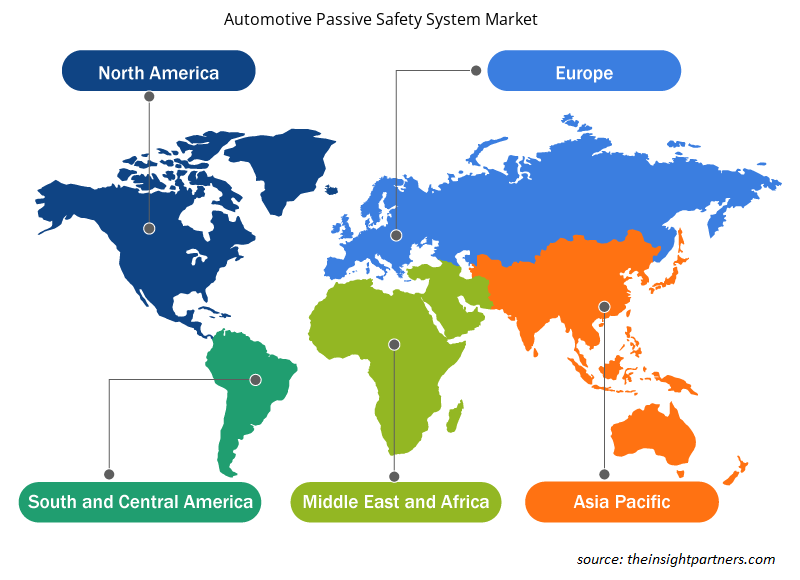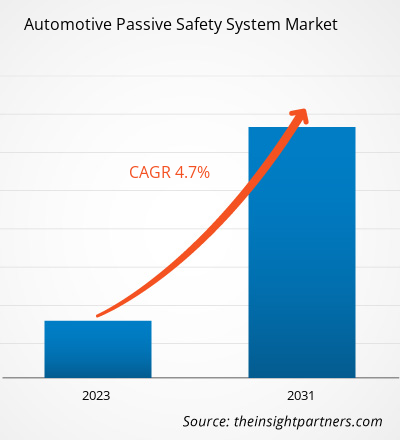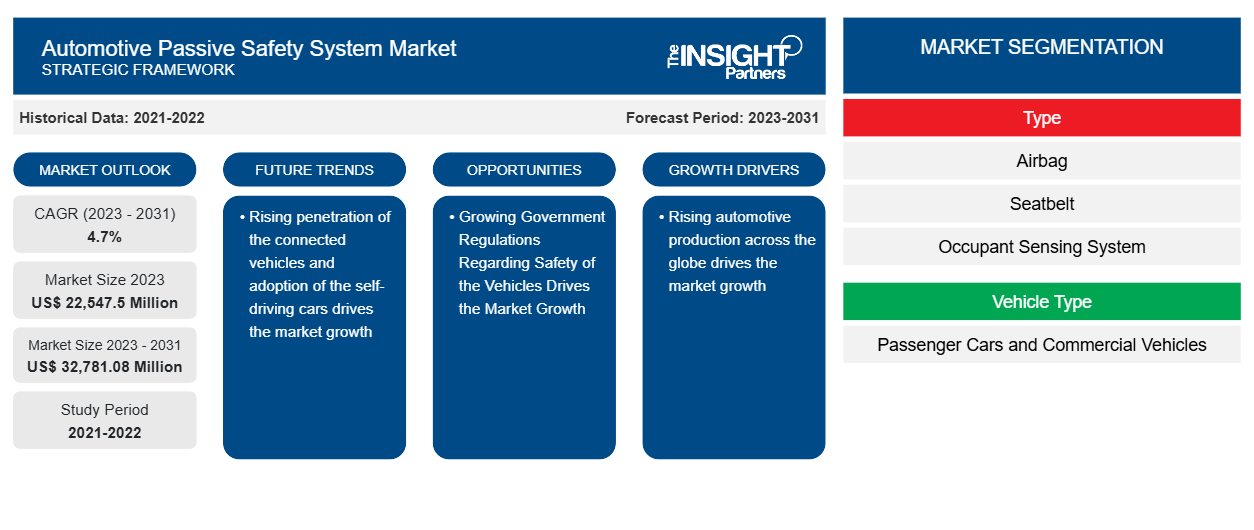من المتوقع أن يصل حجم سوق أنظمة السلامة السلبية للسيارات إلى 32,781.08 مليون دولار أمريكي بحلول عام 2031 من 22,547.5 مليون دولار أمريكي في عام 2023. ومن المتوقع أن يسجل السوق معدل نمو سنوي مركب بنسبة 4.7٪ خلال الفترة 2023-2031. من المرجح أن يظل التبني المتزايد للسيارات ذاتية القيادة في جميع أنحاء العالم من الاتجاهات الرئيسية في السوق. تكتسب السيارات ذاتية القيادة زخمًا في جميع أنحاء البلدان المتقدمة مثل الولايات المتحدة وكندا وألمانيا والمملكة المتحدة. يعد الانتشار المتزايد للمركبات المتصلة وتبني السيارات ذاتية القيادة في جميع أنحاء العالم عاملاً رئيسيًا في السوق.
تحليل سوق أنظمة السلامة السلبية للسيارات
تتعامل أنظمة السلامة السلبية في السيارات مع الأحداث غير العادية، وخاصة تلك التي تنطوي على ركاب في السيارة. تعمل أنظمة السلامة السلبية على تخفيف آثار الأحداث غير الطبيعية، مثل الحوادث. تشمل هذه الأنظمة الوسائد الهوائية وأحزمة الأمان ومناطق الاصطدام ومقصورات الركاب. ساهمت أنظمة السلامة السلبية بشكل كبير في سلامة الطريق والسلامة الشخصية على مدى العقود الماضية من خلال الحد من عواقب الحوادث والحوادث. ونتيجة لذلك، تعمل معظم السيارات الأوروبية الآن بشكل جيد للغاية في اختبارات الاصطدام، وتنضج تكنولوجيا السلامة السلبية.
تشمل العوامل الرئيسية المؤدية إلى نمو سوق أنظمة السلامة السلبية للسيارات التوسع المستمر في سوق السيارات والتفضيل المتزايد للمستهلكين للسيارات الأكثر أمانًا. وقد أثار الارتفاع المطرد في حوادث المركبات قلق المستهلكين والحكومات في جميع أنحاء العالم، مما خلق فرصًا لصناعة أنظمة السلامة السلبية. علاوة على ذلك، فإن النمو الكبير في سوق السيارات بسبب ارتفاع الدخل المتاح يوفر فرص نمو لسوق أنظمة السلامة السلبية للسيارات.
نظرة عامة على سوق أنظمة السلامة السلبية للسيارات
إن مزايا التحول الرقمي للسكان بشكل عام تؤدي إلى زيادة تبني التحول في المنطقة. ومع نمو معدل الإلمام بالقراءة والكتابة في المنطقة، أصبح المزيد والمزيد من الناس على دراية بهذه المزايا. تجاوز عدد المركبات الجديدة المباعة في الدولة عدد المركبات في العام السابق (2018). ونتيجة لذلك، من المرجح أن يكون لارتفاع مبيعات المركبات الجديدة في الدولة تأثير مفيد على نمو السوق في السنوات القادمة. تشمل الشركات المصنعة الرئيسية لأنظمة السلامة السلبية للسيارات أو العلامات التجارية للسيارات في صناعة السيارات الإنتاج والتوزيع والمبيعات وخدمات ما بعد البيع. يتم إنتاج أنظمة السلامة السلبية مثل الوسائد الهوائية وأحزمة الأمان ونظام استشعار الإشغال ونظام سلامة الأطفال وما إلى ذلك بشكل أساسي من قبل شركات السيارات الكبرى. بعض شركات السيارات المتخصصة في إنتاج أنظمة السلامة النشطة والسلبية هي Hyundai Mobis وContinental AG وAutoliv، Inc. يؤدي النمو المتزايد في إنتاج المركبات الكهربائية والاهتمام المتزايد بين الاقتصادات النامية والمتقدمة إلى زيادة الطلب على أنظمة السلامة السلبية. تنتشر عمليات كبار اللاعبين مثل Continental AG وAutoliv وHyundai Mobis وFord وTesla في جميع أنحاء العالم. تشمل عمليات التوزيع والمبيعات شركات الخدمات اللوجستية والتجار والموزعين. كما تساعدهم على تقليل نفقات التصنيع والشحن. تتعاون الهيئات التنظيمية والمنظمات لتعزيز سلسلة التوريد مع الحفاظ على تدفق التجارة.
قم بتخصيص هذا التقرير ليناسب متطلباتك
ستحصل على تخصيص لأي تقرير - مجانًا - بما في ذلك أجزاء من هذا التقرير، أو تحليل على مستوى الدولة، وحزمة بيانات Excel، بالإضافة إلى الاستفادة من العروض والخصومات الرائعة للشركات الناشئة والجامعات
-
احصل على أهم اتجاهات السوق الرئيسية لهذا التقرير.ستتضمن هذه العينة المجانية تحليلاً للبيانات، بدءًا من اتجاهات السوق وحتى التقديرات والتوقعات.
محركات وفرص سوق أنظمة السلامة السلبية للسيارات
ارتفاع إنتاج السيارات في جميع أنحاء العالم
إن اتجاهات التحضر، وزيادة متوسط الدخل المتاح لسكان المناطق الحضرية التي مكنت الناس من تحسين أنماط حياتهم، قد أدت إلى تسريع الطلب على سيارات الركاب. ونتيجة لذلك، تعمل شركات صناعة السيارات في جميع أنحاء العالم على زيادة الإنتاج لتلبية طلب العملاء. وقد زاد إنتاج المركبات، وخاصة سيارات الركاب والمركبات التجارية، بشكل مطرد في كل من البلدان المتقدمة والنامية في السنوات الأخيرة. إن زيادة إنتاج المركبات تعني المزيد من متطلبات وحدات أنظمة السلامة السلبية، وخاصة أحزمة الأمان والوسائد الهوائية لتعزيز أمان الركاب. وهذا يعمل كمحرك رئيسي للنمو لسوق أنظمة السلامة السلبية للسيارات العالمية. كما تعمل أسعار الفائدة على القروض المتناقصة على تغذية النمو في صناعة السيارات، مما يدعم مبيعات أنظمة السلامة السلبية. بلغ الإنتاج العالمي للسيارات 93.54 مليون وحدة في عام 2023، ارتفاعًا من 85.2 مليون وحدة في عام 2022. وعلى هذا النحو، فإن النمو في إنتاج السيارات في جميع أنحاء العالم يدفع سوق نمو أنظمة السلامة السلبية للسيارات خلال فترة التنبؤ.
إن تزايد اللوائح الحكومية المتعلقة بسلامة المركبات يدفع نمو السوق
إن التفضيل المتزايد لميزات السلامة المتقدمة في المركبات، وإدخال معايير السلامة الأكثر صرامة من قبل الحكومات في العديد من البلدان، والانتشار المتزايد لوسائد الهواء الستارية والركبة، وخاصة في البلدان النامية، والتقدم التكنولوجي، كلها عوامل تدفع الطلب على أنظمة السلامة السلبية للسيارات. إن ارتفاع تكاليف المواد الخام وتقلبات أسعار الصرف والمنافسة السعرية تعيق سوق أنظمة السلامة السلبية للسيارات. إن السياسات في أوروبا مفيدة لتطوير الأعمال، وهو أحد الأسباب وراء نمو الصناعات المختلفة. اتخذت المفوضية الأوروبية العديد من التدابير لتعزيز تطوير صناعة السيارات في أوروبا، مثل خطة عمل CARS 2023 وGEAR 2030. تهدف هذه التدابير الحكومية الأوروبية إلى مساعدة نمو صناعة السيارات في المنطقة على المدى الطويل، مما سيساعد في تعزيز النمو الإجمالي للسوق الأوروبية.
تقرير تحليل تجزئة سوق أنظمة السلامة السلبية للسيارات
إن القطاعات الرئيسية التي ساهمت في اشتقاق تحليل سوق نظام السلامة السلبية للسيارات هي النوع ونوع السيارة.
- وفقًا للنوع، يتم تقسيم السوق إلى الوسائد الهوائية، وأحزمة الأمان، ونظام استشعار الركاب، ونظام أمان الأطفال، وغيرها. ومن بين هذه المنتجات، ستحظى الوسائد الهوائية بأكبر حصة في عام 2023، وذلك بسبب زيادة الطلب على السلامة في سيارات الركاب.
- وبحسب نوع السيارة، ينقسم السوق إلى سيارات ركاب ومركبات تجارية. ومن بين هذه السيارات، تحظى سيارات الركاب بالحصة الأكبر في عام 2023، وذلك بسبب زيادة مبيعات سيارات الركاب. ووفقًا لوكالة الطاقة الدولية، وصلت مبيعات سيارات الركاب إلى 65.27 مليون وحدة في عام 2023، ارتفاعًا من 58.2 مليون وحدة في عام 2022.
تحليل حصة سوق أنظمة السلامة السلبية للسيارات حسب المنطقة الجغرافية
ينقسم النطاق الجغرافي لتقرير سوق نظام السلامة السلبية للسيارات بشكل أساسي إلى خمس مناطق: أمريكا الشمالية، ومنطقة آسيا والمحيط الهادئ، وأوروبا، والشرق الأوسط وأفريقيا، وأمريكا الجنوبية والوسطى.
من المتوقع أن تحظى منطقة آسيا والمحيط الهادئ بأكبر حصة في عام 2023، وذلك بسبب زيادة إنتاج السيارات في دول مثل الصين والهند واليابان. ووفقًا لوكالة الطاقة الدولية، بلغ إنتاج السيارات في منطقة آسيا والمحيط الهادئ 51.8 مليون وحدة في عام 2023 بزيادة قدرها 6٪ مقارنة بعام 2020. علاوة على ذلك، تنمو أمريكا الشمالية بوتيرة معتدلة خلال فترة التوقعات. في أمريكا الشمالية، من المتوقع أن تدفع مبادرات الحكومة والسياسات الفيدرالية والبرامج لمختلف الصناعات سوق أنظمة السلامة السلبية للسيارات. وقعت الولايات المتحدة وكندا والمكسيك اتفاقية التجارة الحرة لأمريكا الشمالية. تساعد اتفاقية التجارة شركات صناعة السيارات في زيادة عدد مرافق التصنيع وتعزيز سلسلة التوريد لقطع غيار السيارات.
رؤى إقليمية حول سوق أنظمة السلامة السلبية في السيارات
لقد قام المحللون في Insight Partners بشرح الاتجاهات والعوامل الإقليمية المؤثرة على سوق أنظمة السلامة السلبية للسيارات طوال فترة التوقعات بشكل شامل. يناقش هذا القسم أيضًا قطاعات سوق أنظمة السلامة السلبية للسيارات والجغرافيا في جميع أنحاء أمريكا الشمالية وأوروبا ومنطقة آسيا والمحيط الهادئ والشرق الأوسط وأفريقيا وأمريكا الجنوبية والوسطى.

- احصل على البيانات الإقليمية المحددة لسوق أنظمة السلامة السلبية للسيارات
نطاق تقرير سوق أنظمة السلامة السلبية للسيارات
| سمة التقرير | تفاصيل |
|---|---|
| حجم السوق في عام 2023 | 22,547.5 مليون دولار أمريكي |
| حجم السوق بحلول عام 2031 | 32,781.08 مليون دولار أمريكي |
| معدل النمو السنوي المركب العالمي (2023 - 2031) | 4.7% |
| البيانات التاريخية | 2021-2022 |
| فترة التنبؤ | 2023-2031 |
| القطاعات المغطاة |
حسب النوع
|
| المناطق والدول المغطاة |
أمريكا الشمالية
|
| قادة السوق وملفات تعريف الشركات الرئيسية |
|
كثافة اللاعبين في السوق: فهم تأثيرها على ديناميكيات الأعمال
يشهد سوق أنظمة السلامة السلبية للسيارات نموًا سريعًا، مدفوعًا بالطلب المتزايد من المستخدم النهائي بسبب عوامل مثل تفضيلات المستهلكين المتطورة والتقدم التكنولوجي والوعي المتزايد بفوائد المنتج. ومع ارتفاع الطلب، تعمل الشركات على توسيع عروضها والابتكار لتلبية احتياجات المستهلكين والاستفادة من الاتجاهات الناشئة، مما يؤدي إلى زيادة نمو السوق.
تشير كثافة اللاعبين في السوق إلى توزيع الشركات أو المؤسسات العاملة في سوق أو صناعة معينة. وهي تشير إلى عدد المنافسين (اللاعبين في السوق) الموجودين في مساحة سوق معينة نسبة إلى حجمها أو قيمتها السوقية الإجمالية.
الشركات الرئيسية العاملة في سوق نظام السلامة السلبية للسيارات هي:
- شركة أوتوليف
- شركة كونتيننتال ايه جي
- أنظمة السلامة جويسون
- شركة روبرت بوش المحدودة
- شركة ZF فريدريشهافن ايه جي
- فوريسيا
إخلاء المسؤولية : الشركات المذكورة أعلاه ليست مرتبة بأي ترتيب معين.

- احصل على نظرة عامة على أهم اللاعبين الرئيسيين في سوق أنظمة السلامة السلبية للسيارات
أخبار سوق أنظمة السلامة السلبية للسيارات والتطورات الأخيرة
يتم تقييم سوق أنظمة السلامة السلبية للسيارات من خلال جمع البيانات النوعية والكمية بعد البحث الأولي والثانوي، والتي تتضمن منشورات الشركات المهمة وبيانات الجمعيات وقواعد البيانات. فيما يلي بعض التطورات في سوق أنظمة السلامة السلبية للسيارات:
- قررت شركة ZF فصل قسم أنظمة السلامة السلبية وتأسيسه بشكل مستقل بحلول نهاية عام 2023. ويهدف هذا القرار إلى فتح خيارات إستراتيجية جديدة للعمل في مجال أنظمة حماية الركاب وهو نتيجة لمراجعة مستمرة لمحفظة ZF. وفي سياق عملية التحول الحالية في صناعة السيارات، قامت ZF بتقييم وتحليل أعمال التحول المتنامية من ناحية وإمكانات النمو في مجالات الأعمال التقليدية مثل أنظمة السلامة السلبية من ناحية أخرى. وفي عملية الفصل، ترى الشركة أفضل الظروف لتحقيق نمو أقوى وتوسع مستدام لموقف السوق للشركة الثانية في العالم في مجال تكنولوجيا السلامة السلبية من خلال إشراك المستثمرين الخارجيين. (المصدر: النشرة الإخبارية لشركة ZF Friedrichshafen AG، أكتوبر 2022)
- أبرمت شركة Veoneer للسيارات اتفاقية لاستثمار صندوق تديره American Industrial Partners لشراء أعمال أنظمة التحكم في التقييد التابعة لشركة Veoneer من SSW Partners LP. تكمل هذه الصفقة استراتيجية Veoneer وSSW لتوسيع خطوط أعمال الشركتين مثل Arriver Software وActive Safety وأنظمة التحكم في التقييد للسيارات. (المصدر: نشرة Veoneer الإخبارية، فبراير 2024)
تقرير سوق أنظمة السلامة السلبية للسيارات: التغطية والنتائج المتوقعة
يوفر تقرير "حجم سوق نظام السلامة السلبية للسيارات والتوقعات (2021-2031)" تحليلاً مفصلاً للسوق يغطي المجالات التالية:
- حجم سوق أنظمة السلامة السلبية للسيارات وتوقعاتها على المستويات العالمية والإقليمية والوطنية لجميع قطاعات السوق الرئيسية التي يغطيها النطاق
- اتجاهات سوق أنظمة السلامة السلبية للسيارات بالإضافة إلى ديناميكيات السوق مثل السائقين، والضوابط، والفرص الرئيسية
- تحليل مفصل لـ PEST و SWOT
- تحليل سوق أنظمة السلامة السلبية للسيارات يغطي اتجاهات السوق الرئيسية والإطار العالمي والإقليمي والجهات الفاعلة الرئيسية واللوائح والتطورات الأخيرة في السوق
- تحليل المشهد الصناعي والمنافسة الذي يغطي تركيز السوق، وتحليل خريطة الحرارة، واللاعبين البارزين، والتطورات الأخيرة لسوق نظام السلامة السلبية للسيارات
- ملفات تعريف الشركة التفصيلية
- التحليل التاريخي (سنتان)، سنة الأساس، التوقعات (7 سنوات) مع معدل النمو السنوي المركب
- تحليل PEST و SWOT
- حجم السوق والقيمة / الحجم - عالمي، إقليمي، بلد
- الصناعة والمنافسة
- مجموعة بيانات إكسل
التقارير الحديثة
شهادات العملاء
سبب الشراء
- اتخاذ قرارات مدروسة
- فهم ديناميكيات السوق
- تحليل المنافسة
- رؤى العملاء
- توقعات السوق
- تخفيف المخاطر
- التخطيط الاستراتيجي
- مبررات الاستثمار
- تحديد الأسواق الناشئة
- تحسين استراتيجيات التسويق
- تعزيز الكفاءة التشغيلية
- مواكبة التوجهات التنظيمية























 احصل على عينة مجانية ل - سوق أنظمة السلامة السلبية للسيارات
احصل على عينة مجانية ل - سوق أنظمة السلامة السلبية للسيارات